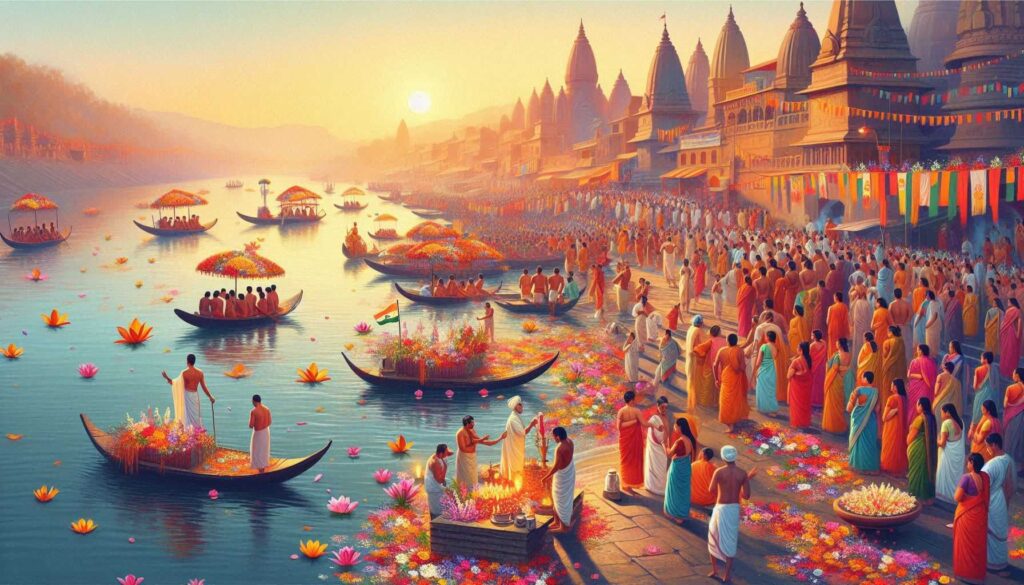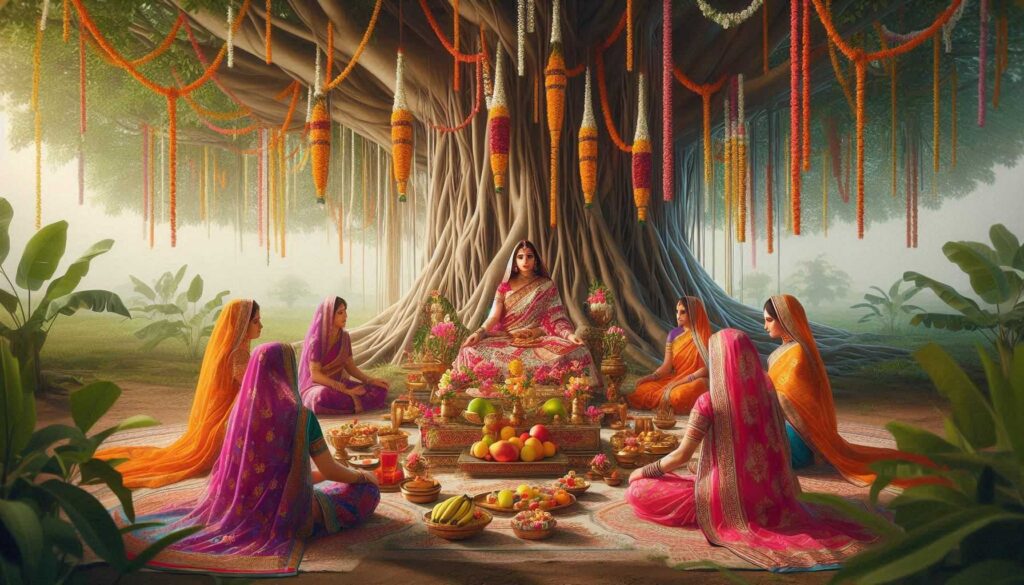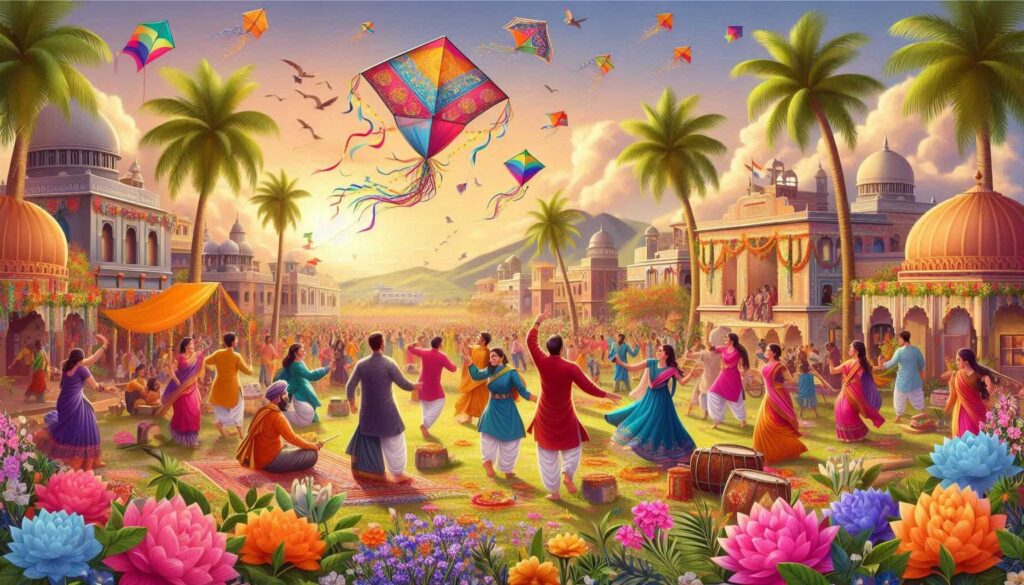1. Ganga Dussehra (June 5th, 2025, Sunday)

Significance:
Ganga Dussehra, celebrated on the 10th day of the waxing moon in the Hindu month of Jyeshtha, marks the descent of the sacred River Ganga from the heavens to the Earth. This festival is dedicated to the purification and worship of the river, which is believed to cleanse sins and offer spiritual liberation (moksha).
Read More About Hindu Philosophy
Rituals and Celebrations:
- Devotees flock to the banks of the Ganga River at popular locations such as Varanasi, Haridwar, and Rishikesh, to take holy dips, believing that it purifies their body and soul.
- Special aartis and offerings of flowers, lamps, and incense are made to the river. In some regions, devotees also release leaf boats carrying lit candles and flowers into the river as a symbol of devotion.
- Temples dedicated to Ganga are decorated, and special prayers are conducted throughout the day.
- In addition to physical cleansing, the festival promotes spiritual purification through acts of charity and fasting.
Quote:
“Jahaan daal daal par sone ki chidiya karti hai basera, woh Bharat desh hai mera” – Traditional verse, symbolizing the spiritual and cultural richness of India, with the River Ganga being at its heart.
2. Nirjala Ekadashi (June 6th, 2025, Wednesday)

Significance:
Nirjala Ekadashi is considered one of the most significant and rigorous Ekadashi fasts in Hinduism. Observed on the 11th lunar day of the waxing moon in Jyeshtha, Nirjala Ekadashi involves fasting from both food and water, hence the name “Nirjala,” meaning “without water.” This fast is believed to bestow the merits of all 24 Ekadashi fasts observed throughout the year.
Rituals and Observances:
- Devotees abstain from food and water for 24 hours, starting from sunrise on Ekadashi until the next morning, when they break their fast after worshiping Lord Vishnu.
- Special prayers and pujas are performed in Vishnu temples, with recitations from sacred texts such as the Vishnu Sahasranama (a thousand names of Lord Vishnu).
- Offering dana (charity) is considered highly meritorious on this day, with devotees donating food, clothes, and other essentials to the needy.
Spiritual Message:
Nirjala Ekadashi symbolizes the spiritual discipline and devotion required to overcome physical desires and attachments. It is a day to focus on the purity of mind, body, and soul, reinforcing the belief that true devotion transcends material comforts.
3. Vat Purnima Vrat (June 10th, 2025, Thursday)

Significance:
Vat Purnima is a festival celebrated by married women in several parts of India, especially in Maharashtra, Gujarat, and Karnataka. On this day, women fast and pray for the long life and well-being of their husbands, drawing inspiration from the story of Savitri and Satyavan. The festival is named after the Vat (banyan) tree, which symbolizes longevity and steadfastness.
Rituals and Celebrations:
- Married women observe a fast and worship the banyan tree by tying a sacred thread around it, circling the tree while offering water, flowers, and prayers.
- Women listen to the story of Savitri, who is revered for her devotion and determination that brought her husband, Satyavan, back from the clutches of death.
- In some regions, women break their fast by eating fruits and sweets after completing the rituals at the banyan tree.
- Vat Purnima highlights the values of marital devotion, love, and sacrifice.
Quote:
“Satyam vada, dharmam chara” – From the Taittiriya Upanishad, reflecting the values of truth and righteousness that underpin the story of Savitri.
4. Mithuna Sankranti (June 14th, 2025, Sunday)

Significance:
Mithuna Sankranti marks the transition of the Sun into the Mithuna (Gemini) zodiac sign. This day, occurring in the Hindu month of Jyeshtha, signifies the start of the solar month of Mithuna, and is particularly celebrated in Odisha as Raja Parba, a festival dedicated to fertility and the earth’s renewal.
Rituals and Observances:
- In Odisha, Raja Parba is celebrated for three days, during which people offer prayers to Mother Earth (Bhuma Devi) for her fertility and abundance.
- Agricultural tools are worshiped, and plowing is paused to allow the earth to rejuvenate.
- Traditional games, dances, and swings are enjoyed, especially by women and young girls, to symbolize joy and the arrival of the monsoon season.
- Special foods, including pithas (rice cakes), are prepared and shared among families and communities.
Cultural Relevance:
Mithuna Sankranti signifies the nurturing and creative aspects of nature, aligning with the agricultural cycles in India. It’s a time for people to express gratitude for the earth’s bounties and prepare for the upcoming monsoon season.
Spiritual Message:
This day serves as a reminder of the importance of spiritual discipline, devotion, and charity. It is a time to detach from worldly distractions and focus on the path of righteousness and devotion to Lord Vishnu.
5. Yogini Ekadashi (June 21st, 2025, Thursday)
Significance:
Yogini Ekadashi is observed on the 11th day of the waning moon in the Hindu month of Ashadha. It is an important day of fasting and prayer dedicated to Lord Vishnu and is believed to cleanse past sins and free one from the cycle of rebirth.
Rituals and Celebrations:
- Devotees fast from sunrise to sunrise the next day, consuming only fruits, milk, or water if needed.
- Prayers and pujas are conducted in Vishnu temples, where the Vishnu Sahasranama and other sacred texts are recited.
- Special emphasis is placed on helping the less fortunate by giving alms, food, and clothes.
- Spiritual discourse focuses on overcoming ignorance and attachment, with stories from the Padma Purana being retold to inspire devotees.
Quote:
“Yada yada hi dharmasya glanir bhavati Bharata, abhyutthanam adharmasya tadatmanam srijamyaham” – Bhagavad Gita, Chapter 4, Verse 7, signifying the eternal presence of Lord Vishnu who reincarnates to restore righteousness.
6. Rath Yatra (June 27th, 2025, Thursday)

Significance:
Rath Yatra, also known as the Chariot Festival, is one of the most grand and celebrated festivals in Hinduism, especially in Puri, Odisha. It commemorates the annual journey of Lord Jagannath, along with his siblings, Balabhadra and Subhadra, from the Jagannath Temple to their garden retreat, known as Gundicha Ghar. This festival symbolizes the divine journey of the Lord and is celebrated with great fervor and devotion.
Rituals and Observances:
- Massive chariots (raths) are constructed for Lord Jagannath, Balabhadra, and Subhadra, decorated with vibrant colors and flowers.
- Devotees participate in the pulling of these chariots through the streets of Puri, a sight that attracts millions of pilgrims and tourists.
- The festival is marked by the chanting of holy hymns, music, dance, and distribution of prasada (blessed food).
- The streets of Puri are filled with stalls offering various foods, religious artifacts, and souvenirs related to Lord Jagannath.
Cultural Impact:
Rath Yatra exemplifies the spirit of community and devotion in Hindu culture. It brings together people from diverse backgrounds and beliefs to celebrate the presence of the divine among them. The festival also highlights the message that God is accessible to everyone, breaking barriers of caste and social status.

